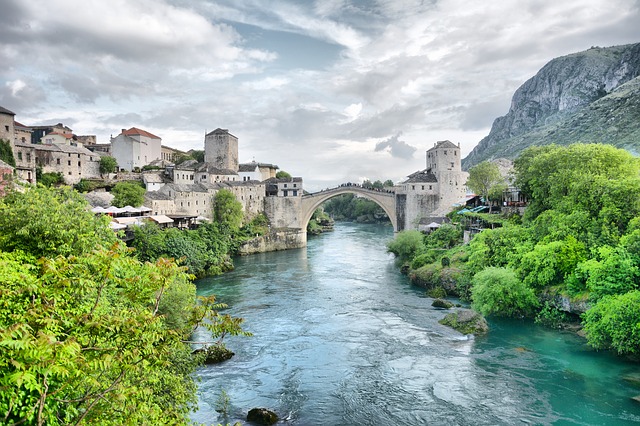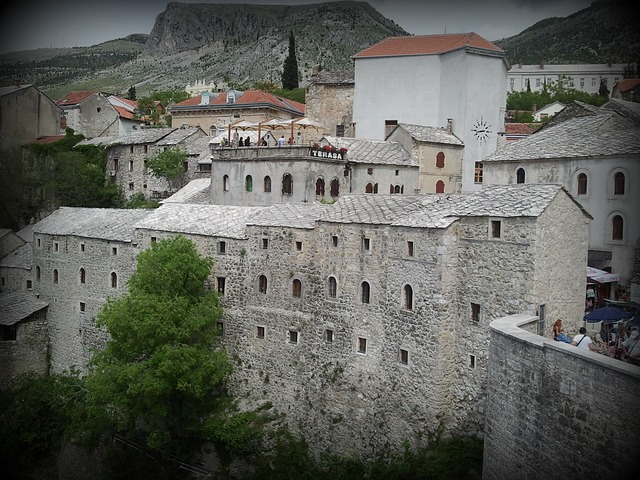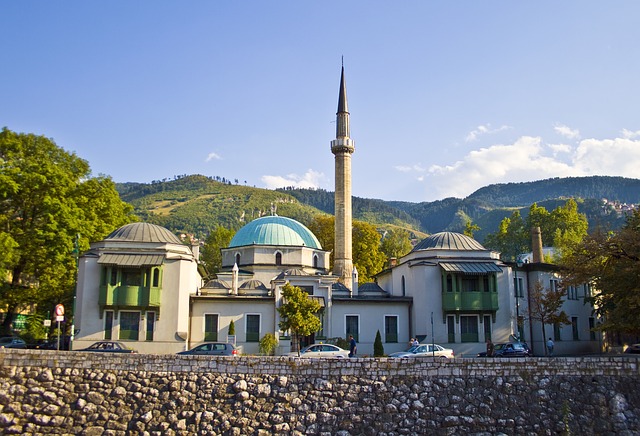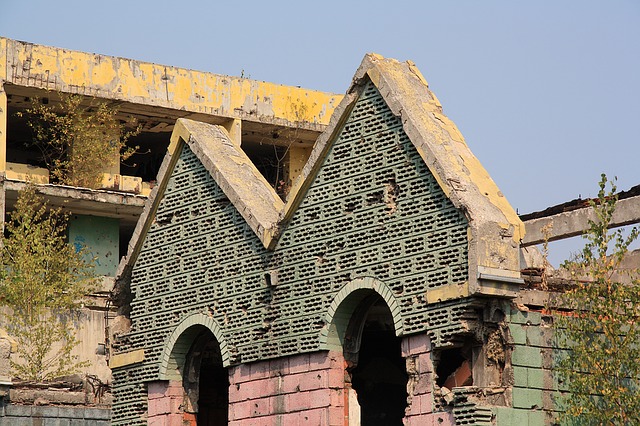Backpacking in Bosnia Herzegovina
Not everyone can imagine anything under Bosnia and Herzegovina. Maybe Sarajevo’s bells are ringing at one or the other – wasn’t there something about an assassination and the First World War? And wasn’t there a war in Bosnia recently? Is it still there?
But the fact is that the country, which covers just 51,197 km², deserves more than just catastrophic attention. Bosnia and Herzegovina shone with untouched nature, fascinating architecture, an incredibly multi-layered history and delicious street food. So it’s time to discover this hidden jewel in the Balkans – before everyone does.
Unlike its neighbour Croatia, which is blessed with miles of coastline, Bosnia and Herzegovina lies almost entirely in the Dinaric Mountains. The capital, Sarajevo, lies in a basin surrounded by high mountains, on which the 1984 Winter Olympics even took place.
But Bosnia and Herzegovina are not only surprised by this. It is also the only predominantly Muslim country on the European mainland (assuming that Turkey is not one of them). About 70 % of the population are Muslims – mostly Bosniaks – the rest predominantly Serbian Orthodox or Catholic.
These different religions among the Bosniaks, Serbs and Croats living in Bosnia finally led to the Bosnian war in 1992, which lasted until 1995 and cost the lives of about 100,000 people. The country still suffers from the long-term consequences of the war and the trenches between the population groups are not yet closed.
Nevertheless: Bosnia is too beautiful to be ignored because of the difficult political situation – which will not touch a traveller anyway. Another advantage: Bosnia is unbeatably cheap! And you don’t have to worry about the language either: Many Bosnians sought asylum in Germany during the war and have a perfect command of German.
Bosnia is surprisingly easy to travel by bus or train – although not really comfortable. A rental car is also a good option for exploring neighbouring countries such as Croatia, Serbia or Montenegro immediately afterwards. In the meantime, some low-cost airlines like WizzAir have already discovered Bosnia for themselves and mainly offer flights to Tuzla or Sarajevo in the summer months.
And even if the consequences of the war can still be seen everywhere in bullet holes on the walls, dilapidated buildings and mine warnings in the forest, nobody who travels in Bosnia and Herzegovina has to worry about his safety. The Bosnians are very cordial, open-minded people and even in the evening or at night you can take to the streets without hesitation. So there is nothing against discovering this wonderful country.
Culture in Bosnia and Herzegovina
Well, what is typical Bosnian-Herzegovinian? This is difficult to say in a country that is a true melting pot of culture and religion.
But all Bosnians have one thing in common: a friendly, open manner. Nothing in Bosnia is easier than talking to locals and internationals. People are very curious about strangers. And as already mentioned: Many people speak a perfect German and like to remember their time in Germany. Many people also tell relatively frankly about the war or politics in the country, as a normal traveller you can learn an incredible amount from the people on the street if you address the subject subtly and prudently.
Since the Bosnian population consists of three large groups belonging to all different religions and nations, Bosnia and Herzegovina celebrates Muslim holidays such as Bayram, Christian holidays such as Christmas and Orthodox holidays. The country is also a vibrant mix of religions. You’ll see girls in miniskirts as well as women in burkas.
You can eat a burger at McDonald’s and then drink a traditional Bosnian coffee that is very reminiscent of the Turkish one. Although it would be a shame to go to McDonald’s because Bosnian cuisine has so many delicacies to offer. The best known are probably the Cevapcici. Bosnians are also super hospitable. If you make friends on the street or get along well with your hosts, it’s quite possible that you’ll be invited to dinner. Then it’s time: Accept, enjoy – and if you are invited into the house, please take off your shoes.
The Bosnians themselves have a stoic composure and at the same time an explosive temperament – this will be especially noticeable when driving a car. Rules do not always and everywhere apply and many young people who leave the country criticise the lack of willingness to act on the part of their fellow citizens, which would be necessary to really change something.
Because of this diaspora, children who study or work abroad and then don’t come back, Bosnia is one of the oldest countries in the world, with an average age of almost 50 years. Of course you will meet young people anyway – many of them unemployed. But the bigger cities don’t really start humming until the summer months, even though the Wegzügler are on home leave.
More Backpacker information about Bosnia and Herzegovina
in general, Bosnia and Herzegovina is not an expensive travel destination. The convertible mark used to be pegged as a currency to the German mark – now it is pegged to the euro, which makes conversion super easy for travellers. Each amount in Marks is divided by two by the Euro amount.
However, Bosnia is not yet fully developed for tourism. The infrastructure, which suffered from the war, is still not restored in parts, the roads are bad and full of potholes. Nevertheless, you can usually get from A to B without any problems if you only know where to get the necessary travel information.
Many towns or villages are only served by bus once or twice a day. In cities like Mostar or Sarajevo there are information boards or counter halls at the station or bus station where you can get good advice. In smaller villages it can happen that the bus stop is not even marked as such. It is therefore generally advisable to ask for the return or onward journey before travelling to a destination, wherever you can find a reliable counter hall. Normally, however, the hostel or hotel owner in the respective village can also provide information on when and where to continue.
To some sights you have to plan a longer walk, because the last bus stop is a few kilometres away. Again, sometimes there are no timetables, so simply ask the bus driver for the last connection before you jump onto the trail.
All this makes travelling in Bosnia a little more complicated, but fortunately there are always nice and helpful people who can help you. If your budget allows it, a rental car is of course also an alternative. But it is best to drive only during the day, because the roads are sometimes in a very bad condition.
Backpacker Route in Bosnia and Herzegowina
Since it is a good idea to travel to Bosnia and Herzegovina in connection with other Balkan countries and to cross from one country to another and back, you don’t necessarily have to decide on a fixed route for Bosnia alone. The north of the country can be combined well with a Serbia trip, the south invites to make a detour to Croatia. The possibilities are very numerous. However, there are a few hotspots in Bosnia that you shouldn’t miss out on.
A suggested route for backpacking in Bosnia and Herzegovina
- Day 1-3: Sarajevo and surroundings
- Day 3-4: Mostar and visit to the old dervish monastery in Blagaj (possibly an extra day for rafting on the Naretva river)
- Day: 5-7: Medugorje, from there day trips to Poticelj and Kravice
- Day 8-9: Trebinje with day trip to the Bilecko Jezero Reservoir
And after that? Maybe on to Montenegro or Croatia? Or discover even more of Bosnia? The route can be extended or extended at will. Most of the sights are located in the south of Bosnia and Herzegovina. The north, the Serbian Republic of Srpska, which also runs through the centre of Bosnia, is generally much poorer. At the border to Croatia there are still some small, sweet villages, but then a visit to the Plitvice National Park in the neighbouring country is more appropriate.
Travel times in Bosnia and Herzegovina
Bosnia is a country with a continental climate with cold winters and hot summers. In general, the winters remain milder in the south, where the climate is already Mediterranean. Around Sarajevo and in the north there are also excellent ski resorts.
Since Bosnia and Herzegovina is not yet so touristically developed and overcrowded, it makes no big difference whether you travel in the tourist season. In summer, Bosnians living abroad are often at home, but that doesn’t raise the price level in the cities. However, accommodation is often scarce.
In general, the summer months, autumn or spring would be the best months for travelling. From April to September is thus the best travel time for Bosnia, however, it can get hot in the summer months up to 40 degrees. Especially in the area around Mostar it is always hotter than in the rest of the country. And also towards the Dalmatian coast, the temperatures are very high. If you don’t like it too hot, you should limit yourself to autumn and spring. This is also the ideal time to explore the Bosnian mountains while hiking.
Backpacker Budget in Bosnia and Herzegowina
For the fact that Bosnia is not so comfortable to travel to, it is unbeatably cheap.
Even in the middle of the city centre, right next to a tourist attraction, you can easily afford a good meal. It won’t cost you more than 10 marks under any circumstances. Beer and wine cost between 3 and 6 marks. Wine is usually a little more expensive. Even if you eat three meals a day with a drink in the restaurant, you will get there with about 20 Euros.
Museums and sightseeing usually cost only a few marks admission. As a student you will only have to pay a few cents. Pure “tourist museums” or art exhibitions are somewhat more expensive. But you probably won’t have to pay more than 10 marks there either. And also activities like rafting are very cheap with daily prices of around 30 Euro.
Bus and train in Bosnia and Herzegovina
For the transport you can calculate between 6 and 10 Euro depending on the length of the route. But it shouldn’t get any more than that. Trains are generally somewhat cheaper than buses, as there are no real low-cost providers for longer distances, such as Flixbus.
- Train Sarajevo – Mostar: 12 KM
- Bus Mostar – Dubrovnik: 20 KM for the whole route
- Bus Dubrovnik – Sarajevo: 30 KM
Taxi driving in Bosnia and Herzegovina
A 10-15 minute taxi ride costs 2-3 Euro. There are no taxis in Bosnia, so you have to use normal taxis. You can recognize the normal taxis by a “T” in the license plate. Everything else is illegal taxi drivers.
However, it is normally no problem to drive an illegal taxi. It only means that the driver has not acquired an official license, which is simply too expensive for many people.
For both legal and illegal taxi drivers, however, you have to be equally careful not to get ripped off. Make sure that the taximeter is set. A tip from Locals: Try to talk to the taxi driver and make friends with him. Most Bosnians are curious about strangers and will be happy to talk to you. If you are likeable, you will at least not pay the “tourist rate”.
Driving in Bosnia and Herzegovina
A rental car in Bosnia and Herzegovina offers you of course the highest degree of flexibility and is above all an interesting option, because some sights can only be reached by taxi. At the airport Sarajevo you can get a small car from 15 Euro per day.
Almost the same speed restrictions apply as in Germany, 50 km/h in the city, 80 km/h on the country road and 130 km/h on the motorways. However, there are not many of them in Bosnia. Especially in the south, where most of the sights are to be found, you will have to drive on the country road.
The roads are often in very bad condition, which is why it is not advisable to drive at night. Some of them are really just dirt roads. Here caution is advised if the underbody and the wheel axles of your rental car are to remain intact!
The blood alcohol limit in Bosnia and Herzegovina is 0.2, which means: don’t drink if you’re still driving.
Backpacker accommodations in Bosnia and Herzegowina
The choice of accommodation in Bosnia and Herzegovina is not bad at all. From hostels to hotels, everything is available. You can also rent an Airbnb or private accommodation. Many Bosnians rent rooms in their houses for a few Euros per night on the big well-known portals.
In the high season in summer, however, accommodation can be scarce and expensive. Nevertheless, even as a backpacker with a small budget, you can almost always afford a double room without any problems.
Breakfast usually costs extra, but you can really buy it cheap on the street. Many rooms, even in private accommodation, have a kettle and at least coffee or tea is provided free of charge.
In Sarajevo accommodation is generally the most expensive. Everywhere else it is only cheaper or if it is just as expensive. Therefore here are some prices from Sarajevo for comparison:
- Night in a private accommodation (double room) in Sarajevo or Mostar: approx. 30-60 KM
- Night in a 4-star hotel (double room) in Sarajevo: approx. 120 KM
- Night in hostel (shared room) in Sarajevo: approx. 20 KM
Backpacker Tips, Tricks & Highlights in Bosnia and Herzegowina
It is easy to spend a lot of time in Bosnia and Herzegovina, marveling at the country’s nature and diverse culture. Whether you are a backpacker planning an adventure or a cultural holiday, your wishes will be fulfilled in Bosnia and Herzegovina.
In the north, near the Croatian border, you can marvel at beautiful nature, in the south there are green mountains, waterfalls and springs to which hiking is possible. The cities of the country, such as Sarajevo or Mostar, offer endless culture and interesting insights into life between East and West.
If you like, you can also learn a lot about the history of the country and the war. Most people are very open about their experiences with the topic and you will meet many people of your age who experienced the war directly.
Moreover, Bosnia and Herzegovina is not completely overrun by tourists and you may even be lucky to be the only tourist in one place.
Backpacker Highlights in Bosnia and Herzegovina
The capital Sarajevo
You could spend a whole week in Sarajevo alone. But you probably don’t have that much time. Nevertheless, you should absorb as much of the atmosphere and culture as possible. Because the Bosnian capital has a very special mixture of East and West to offer and is also the perfect starting point for your trip to Bosnia.
Take a look at the old town, Baščaršija, in any case. The old bazaar and city centre. Drink from the Sebilj Fountain there – because legend has it that you will return then. Very worth seeing is also the former town hall of the city, which was completely destroyed during the war and only reopened in 2014.
Stroll along Ferhardija, a street that combines Ottoman and Austro-Hungarian architecture, drink a Bosnian coffee or discover “lost places” like the old bobsleigh track from the Olympic Winter Games.
The Kravica Waterfalls
Bosnia is not called the land of rivers and mountains for nothing. There are countless clear rivers, waterfalls and lakes to admire. The Kravica waterfalls near Studenci, about 20 kilometres away from Mostar, are each about 25 metres high. They extend over a length of 210 metres.
In summer Kravica is a popular destination for swimming and picnics among the Bosnians as well, the fish in the local restaurants is fresh and excellent.
Unfortunately, the waterfalls are not so easy to reach. From Mostar you can take a bus to Međugorje from where you can only take a taxi. But this is affordable for 10 kilometers with a price of about 10 KM.
Mostar
Mostar is the sixth largest city in Bosnia and Herzegovina and although it is not big, you should definitely dedicate an entire day to it. Mostar is really original, full of culture and history and traces of the war of the 90s.
Stroll through the old town, discover the Stari Most, the big bridge that was completely destroyed in 1993 and then painstakingly rebuilt. Every year in September the “Red Bull Cliff Diving” takes place here, where the participants jump from the 19 meter high bridge, which was built in the 16th century.
But also apart from the big bridge you can spend your time in Mostar. There are beautiful jewellery to buy, unfortunately not necessarily the best food in Bosnia, but also in Mostar delicious cocktails and romantic views to the sunset.
Mostar can be reached twice a day by train from Sarajevo – and you should definitely take the train, because the views of the Neretva Canyon are incredible.
The Neretva Canyon
The Neretva, which also flows through Mostar, is one of the coldest rivers in the world. Even in summer the water is sometimes not warmer than 7 degrees (Cliff Diving, anyone?).
The most beautiful part of the river starts behind Mostar, when the Neretva flows through a 20 kilometer long gorge. The water is incredibly clear and turquoise, the canyon from the car, train or bus a place where you just stand in amazement.
But the river with its beautiful nature and its current is also perfect for rafting. In Konjic there are several providers for rafting, thus it is the ideal stopover for the journey from Sarajevo to Mostar or also a good place for a day trip from one of the two cities (approx. 1 hour drive each). A whole day rafting incl. food is also unbeatable cheap with 30-40 EUR.
Vrelo Bune
Vrelo Bune, the source of the Bune River, is a real insider tip in Bosnia, a real Hidden Gem. The spring in Blagaj is one of the largest in Europe and flows directly from a cave located in a 200 metre high mountain.
As if that weren’t enough, there is an old 16th century dervish monastery at the edge of the spring that was built directly into the mountain. The so-called Tekija is almost completely preserved and nestles impressively into the rocks under which the river shoots with enormous force from its source.
Blagaj can be reached by bus from Mostar – but there is no official bus station in Blagaj itself. It is advisable to ask the bus driver about the departure times for the trip to Mostar.
Počitelj
One of the most beautiful, photogenic villages in Bosnia is certainly Počitelj. With an estimated foundation date of 1383 the village has a lot of culture, mosques, ancient houses with wooden shingles and small lanes to offer. It is built directly into the mountain, at the foot of the mountain flows the Neretva.
The bus from Sarajevo to Mostar unfortunately does not stop at Počitelj, so once again there is only the taxi. From Mostar it is about 10 KM. And they are worth every cent.
Food & Drinks in Bosnia and Herzegowina
Bosnia and Herzegovina is a predominantly Muslim country, which means that there is hardly any pork. Mostly beef and lamb, sometimes chicken. All in all the Bosnian cuisine is very meaty, a delicacy is lamb on a spit.
Bosnian cuisine also has many Mediterranean and Turkish influences, which are reflected in many dishes. The desserts, for example, are very sweet, prepared with syrup and sugar and flat bread is a common accompaniment to many dishes.
Typical dishes in Bosnia and Herzegovina
It is also common for Bosnia to have only one traditional dish in some restaurants. In Ćevapdžinicas Ćevapi is grilled, which is then served in flat bread with raw onions and kajmak (something like sour cream).
In the so-called Buregdzinica you can buy pita. Rolled puff pastry, which is filled with meat (Burek), cheese (Sirnica), spinach (Seljanica) or potatoes (Krompiruša). Traditionally, yoghurt is not salty as in Turkey, but simply slightly thinner than normal yoghurt. So vegetarians also get their money’s worth here.
Another Bosnian speciality is grilled lamb on a spit. Everywhere in the country, but especially in Jablanica, you can find restaurants that offer the dish and grill the lambs fresh right in front of the door. The lamb becomes particularly tasty and tender by rubbing it with coarse sea salt.
You can get a good meal in Bosnia for just 5 KM (2 Euro). In a good restaurant it is between 10 and 15 KM.
Drinks in Bosnia and Herzegovina
The Bosnians have a coffee culture not unlike that of the Turks. It is common practice to sit in a restaurant for several hours while enjoying a cup of coffee, talking and watching people. The Bosnian coffee is put into a special copper pot and boiled on the stove until it forms foam. It is then served in espresso cups with a sweet similar to Turkish honey and sugar. The Bosnians do not add the sugar to the coffee, but dip the cube into it and then eat it.
Since Bosnia is a Muslim country, you will not be able to buy alcohol in some restaurants. However, there is a very good local and cheap beer, the Sarajevska. There are also local Bosnian and Macedonian wines to buy. Alcohol is not quite cheap, but in comparison to Germany a beer is only 3-4 KM. The price for wine is 5-8 KM.
The water in Bosnia is very clean and can usually be drunk without hesitation from the tap.
Backpacker Visa and vaccinations in Bosnia and Herzegowina
Visa for Backpacker
There will be no problems at all when entering Bosnia and Herzegovina. You may enter Bosnia and Herzegovina for 90 days. You can enter Bosnia and Herzegovina with your passport and identity card.
You are obliged to report to the immigration police within 24 hours and to make sure that you are in the country. In general, there are no problems if this does not happen – there can be a penalty, however, if you are checked out or re-entry. It is therefore your responsibility whether you report or not.
The Federal Foreign Office also advises not to leave the paved roads because of the continuing danger of mines.
Vaccinations and health precautions for Bosnia and Herzegovina
Epidemics or exceptional diseases are not to be expected in Bosnia. However, every backpacker should have a standard vaccine against tetanus, diphtheria, hepatitis A and polio. If you are planning hikes, rabies or TBE and a hepatitis B vaccination may also be useful.
You should also note that medical care is not quite comparable to German standards. Especially in rural areas it can happen that doctors do not speak English or German. So it makes sense to pack a good first-aid kit so that you only have to go to the doctor in emergencies.
Also important: The European Health Card is not valid. So be sure to take out travel health insurance.







